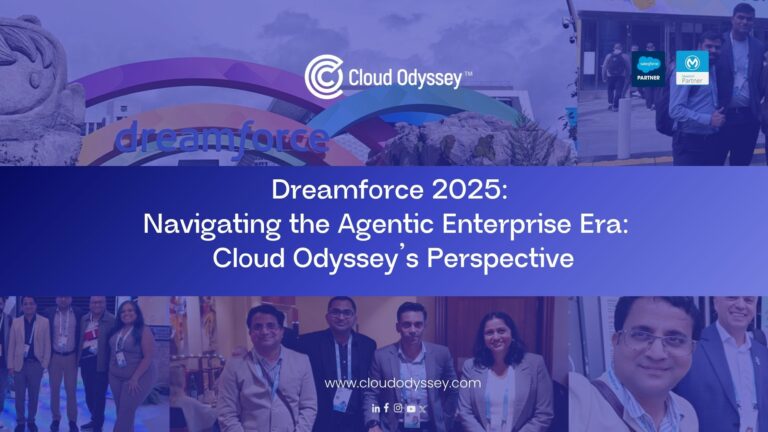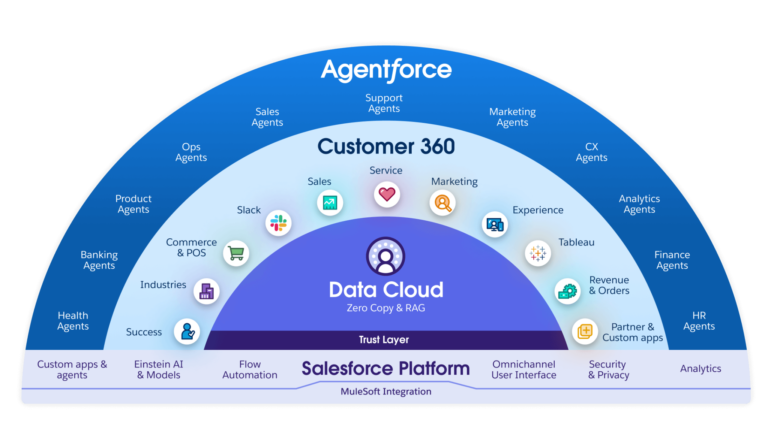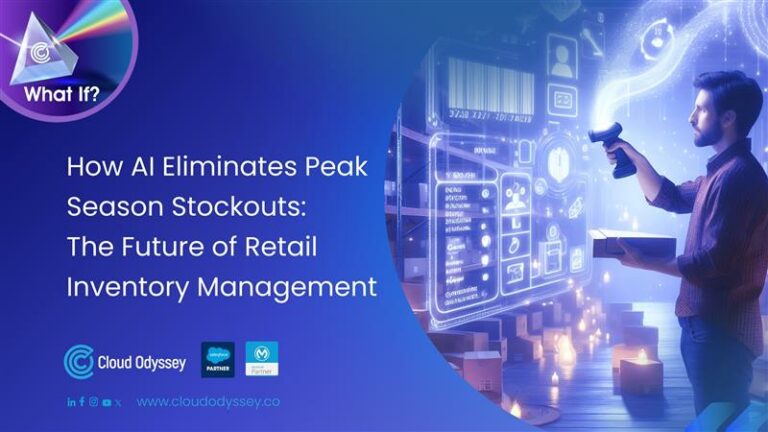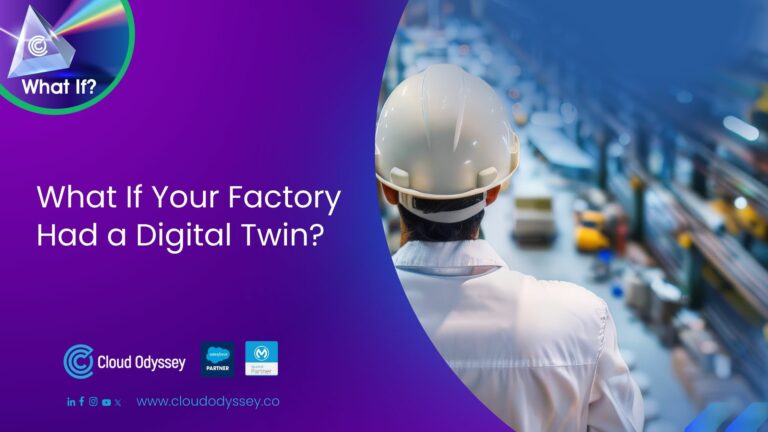The Dawn of a New Enterprise Paradigm
Dreamforce 2025 wasn’t just another product showcase—it was a strategic declaration that enterprise computing has crossed a threshold. Matthew McConaughey opened the keynote describing Agentforce as evolving from “the whisper” of a year ago to full-blown reality, welcoming attendees to the “Agentic Enterprise.” With over 2,000 sessions spanning 2 million square feet of the Moscone Center campus, the conference marked a decisive shift from experimental AI pilots to agentic AI: autonomous, enterprise-grade agents capable of orchestrating workflows and delivering measurable outcomes at scale.
As Salesforce Chair and CEO Marc Benioff articulated in his keynote, enterprises today face “the agentic divide” — where AI thrives in consumer applications but struggles to gain traction within enterprise environments. What we witnessed was the evolution of AI from an auxiliary tool to a core component of the enterprise operating model.
Cloud Odyssey’s Take: This represents a transformative inflection point for organizations. Those that successfully integrate autonomous agents—governed by trusted data and robust operational frameworks—will secure sustainable competitive advantages. Conversely, enterprises attempting incremental adoption without structural change risk falling behind in productivity, decision-making, and operational resilience.
Understanding the Shift: From Generative to Agentic AI
Over the past few years, enterprises experimented extensively with generative AI across marketing, customer service, and analytics, producing impressive outputs but limited tactical impact. As highlighted in a recent MIT study referenced during the keynote, 95% of generative AI pilot projects have failed to scale due to fragmented workflows, siloed data, and inadequate governance.
Dreamforce 2025 marked the pivot toward AI agents that actively decide and act across enterprise workflows—not merely assist humans in isolated tasks. Benioff emphasized that becoming a true agentic enterprise requires getting four things right: data, integrated solutions, priorities, and governance. He revisited Salesforce’s three classic pillars—trust, data, governance—explaining how they’re now prerequisites for reliable AI, with context, rather than prompts, serving as the ‘secret sauce.’ The vision emphasizes weaving AI into the operational fabric where employees collaborate with AI agents rather than competing with them.
The Agentic Enterprise: Three Foundational Pillars
Salesforce articulated a comprehensive vision where AI agents operate throughout the enterprise, executing processes, monitoring outcomes, and interfacing seamlessly with humans and systems:
1. Autonomous Execution: Agents take action without constant human input while maintaining oversight mechanisms for critical decisions—the balance between autonomy and accountability that defines enterprise-grade agentic AI.
2. Unified Data Foundations: Agents operate on a single, reliable source of truth through Data 360, ensuring actions are accurate, consistent, and auditable.
3. Governance and Risk Management: Enterprise-grade policies, monitoring capabilities, and audit mechanisms are embedded directly into the platform, preventing operational errors and regulatory breaches before they occur.
AI is no longer simply a productivity tool—it’s a core operational layer influencing workflow design, governance structures, and talent requirements.
Agentforce 360: Enterprise-Scale AI Infrastructure
Central to Dreamforce 2025 was Agentforce 360, described by Benioff as evolving dramatically: “A year ago, Agentforce was a product. Now it’s a platform.” This fourth edition brings together Sales, Marketing, Commerce, Slack, Tableau, and MuleSoft under one agentic layer—functioning like connective tissue where every app can call on the same models, context, and observability framework.
Unlike traditional AI tools focused primarily on modeling capabilities, Agentforce 360 prioritizes enterprise readiness through:
- Data and integration layer powered by Data 360, serving as the intelligence layer for the entire platform
- Governance and observability with Agent Observability scoring every agent in real-time and pre-built controls
- Hybrid reasoning engine (Atlas) balancing AI creativity with reliable business processes
- Agent-to-agent communication enabling collaboration across systems and workflows
- Model flexibility allowing customers to choose their own LLMs without losing visibility
- 300+ industry-ready agents designed for verticals like financial services, healthcare, and manufacturing
- Agent Script canvas offering precise control over agent behavior
This architecture provides a framework to scale AI confidently while maintaining trust, visibility, and regulatory alignment—deploying autonomous agents without sacrificing control.
Data 360: The Intelligence Foundation
Dreamforce 2025 saw the rebranding of Data Cloud to Data 360, repositioning it as the intelligence layer for the entire agentic platform with enhanced capabilities for unstructured data, stronger governance and data masking, and direct context pipelines into Slack and Agentforce applications.
FedEx exemplified this capability, leveraging Data 360 to process two petabytes of data and 100 billion daily transactions, automatically reactivating customers and powering Agentforce IT Service through pattern recognition that diagnoses incidents and deflects tickets.
Agentforce Vibes: Democratizing Agent Creation
Agentforce Vibes represents a genuine leap forward for builders—allowing users to describe what they need in plain language while the platform generates the app, Flow, and data connections automatically within seconds.
Patrick Stokes demonstrated this by creating a Dreamforce Command Center simply by prompting the system to build a dashboard showing opportunities by region. The platform created and deployed the complete application in moments, demonstrating faster prototyping for administrators and the future of low-code/no-code development for developers.
Slack: The Intelligent Operating System for Agents
One of Dreamforce 2025’s most strategic revelations was Slack’s evolution into an “agentic operating system.” As Benioff explained, “Today, I’ve got dozens of agents that are helping me to make my Slack environment better, more efficient, renew my customers, sell more effectively. Slack has become an agentic OS.”
Rather than serving solely as a messaging platform, Slack now functions as the interface where human employees supervise, guide, and interact with AI agents. Agents surface insights, approvals, and tasks directly inside channels—sellers receive next-step prompts, service teams access real-time customer context, and IT teams trigger remediation flows without leaving their workspace. The new Slackbot acts as a personal AI companion capable of reasoning through complex tasks.
Importantly, while Slack remains central to the Agentforce experience, the platform is designed to work wherever people work—including Microsoft Teams—ensuring agentic capabilities reach employees regardless of their preferred collaboration tools. By co-locating human decision-making and AI execution within familiar interfaces, organizations accelerate adoption and realize tangible outcomes faster.
Real-World Validation: Early Adopters Leading the Way
Dreamforce 2025 showcased compelling deployments moving well beyond prototypes to production systems that actively move the needle:
Williams-Sonoma: Launched “Olive,” an AI sous chef helping customers plan meals and select gift sets—built in 30 days and deployed live during the conference.
PepsiCo: Plans to become “agentic AI-first by end of 2026,” with agents already generating 25-30% efficiency gains across 1.5 million stores, targeting 5 million by 2026.
Pandora: Deployed “Gemma,” an agent merging shopping and service through Agentforce Voice. CTO David Walmsey noted, “We got the cellophane off the software in January, and it worked straight out of the box.”
Dell Technologies: CEO Michael Dell emphasized automating “donkey work” to free humans for high-value activities. Dell cut supplier onboarding from 60 days to 20 using Agentforce Supply Chain.
FedEx: Leverages Data 360 to process two petabytes of data and 100 billion daily transactions, converting opportunities into “boxes on the belt” across 220+ countries.
With over 12,000 customers experimenting with Agentforce, the combination of rapid implementation, measurable ROI, and production readiness validates that agentic AI has matured to enterprise-grade capability. Enterprises deploying agents holistically—spanning front-office, back-office, and internal operations—capture sustained value most effectively.
Governance and Data Trust: The Non-Negotiable Foundation
Dreamforce 2025’s most critical message emphasized governance, transparency, and risk mitigation. Auditability, version control, data masking, and policy enforcement emerged as fundamental requirements—not optional features—for enterprise-scale AI.
Governance is the backbone of successful agentic AI adoption. Organizations prioritizing governance from day one achieve faster, more reliable, and sustainable outcomes, while those neglecting it face operational inefficiencies, compliance violations, and reputational damage. Agentforce 360’s architecture embeds governance at every layer, reflecting that trust and control are prerequisites for scaling autonomous AI.
Leadership Imperatives: What This Means for Your Role
For Chief Information Officers: Invest in data unification, platform readiness, and governance mechanisms—the technical foundation you build today determines your organization’s agility tomorrow.
For Chief Marketing Officers: Shift from campaign-level execution to AI-driven orchestration of personalized, adaptive experiences across all touchpoints.
For Chief Operating Officers: Redesign processes and KPIs to account for hybrid human-agent performance—traditional efficiency metrics no longer capture operational excellence.
For Human Resources Leaders: Cultivate new skills and roles supporting AI agent design, monitoring, and governance—the agentic workforce requires different capabilities and mindsets.
Organizations failing to address structural, operational, and cultural elements risk limiting AI’s impact while exposing themselves to significant operational and compliance risks.
The Path Forward: Seizing the Agentic Moment
Dreamforce 2025 delivered an unmistakable message: AI has evolved from assistive technology to a foundational component of the enterprise operating model. This is the present reality.
Salesforce’s trajectory signals confidence with a FY30 revenue target of $60 billion (10% organic CAGR), expanded partnerships with Anthropic and OpenAI (enabling Agentforce 360 in ChatGPT and GPT-5 integration), and a $15 billion investment in San Francisco’s AI infrastructure over five years.
Organizations embracing the agentic enterprise—integrating autonomous agents responsibly with embedded governance—will define the next era of competitive advantage. Those treating AI as a core operational layer and designing for hybrid human-agent collaboration will capture measurable efficiency gains, reduced operational risk, and sustained strategic advantage.
The question is not whether to transform, but how quickly and how effectively.
Partner for Success
Ready to navigate the agentic enterprise transformation?
Partner with Cloud Odyssey to implement, scale, and govern AI/Agentforce across your enterprise. Our proven experience ensures your AI initiatives are not only innovative but enterprise-ready, compliant, and outcome-driven—unlocking productivity, agility, and growth in the agentic era.
Let’s build your agentic future together.









